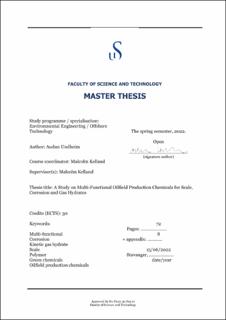| dc.description.abstract | Oilfield production chemistry is a wide field which includes many different areas and related difficulties. In this work, focus is on mitigating scale, corrosion, and gas hydrates using chemical inhibitors. Production lines often require chemical treatment for several problems simultaneously, which may cause incompatibility issues. The development of multi-functional inhibitors is based on the idea of treating all three issues simultaneously and avoiding incompatibility. As a part of this development, the ability to test the corrosion inhibition of a compound was paramount. Using the Gamry EuroCell Electrochemical Cell a CO2 corrosion testing method was reviewed and optimized to reduce deviation and increase replicability. The optimized method was used to test various compounds to investigate which functional groups that could be interesting to include in future inhibitor syntheses. The major results found from this testing were that 500 ppm of a commercial imidazoline exhibited a corrosion inhibition efficiency of 85.4±2.2 %, and that none of the synergists by themselves tested achieved higher efficiency. The compound with highest efficiency was found to be sodium lignosulfonate which exhibited an efficiency of 95.9±1.6 %. An experimental polymer based on polymaleic anhydride reacted with 3,3-dibutylaminopropylamine (DBAPA) and vinylcaprolactam (VCap), abbreviated PMA:VCap-DBAPA, was tested as a CI, both by itself and with various synergists. While the polymer by itself at 500 ppm exhibited an efficiency of 18.1±6.6 %, this was increased to above 90 % by the addition of five separate synergists at 100 ppm, of which the highest was ammonium thiocyanate at 96.0±1.5 %. Overall, synergists with thiol functional groups seemed to generally provide good synergism with PMA:VCap-DBAPA. While synergists with functional groups embedded within a ring structure generally provided poor synergism with PMA:VCap-DBAPA.
Two other projects to synthesise polymers with multi-functional character were also carried out. The synthesis of poly(1-oxy-3-lactam vinylene) was successful for polyoxyvinylcaprolactam (POVCap) and polyoxyvinylpiperidone (POVPip). Copolymers of POVCap and POVPip were tested as corrosion and gas hydrate inhibitors. It was found that a copolymer of 36 % POVCap and 64 % POVPip exhibited a hydrate onset temperature of 11.6±0.1 ºC, and corrosion inhibition efficiency of 15.4±3.6 % for pure POVPip. While corrosion results were somewhat higher for copolymers at different ratios, the increased efficiency is likely due to the insoluble part of copolymers with a high molar fraction of OVCap. None of the synergists tested managed to achieve a similar synergism with POVCap as with other polymeric caprolactam containing kinetic gas hydrate inhibitors. Finally, the synthesis of hyperbranched polyamine containing imidazolidine rings based on a publication from a Chinese group was unsuccessful. Many attempts were made with different variations of the synthesis, but none were found to produce the described product. | |
